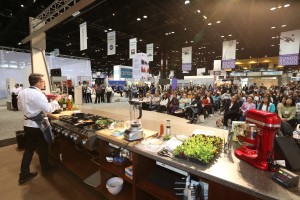IH+HS 2015 Indicates Positive Outlook for Housewares Industry
 This year’s International Home + Housewares Show sold out booth space in record time, had 2,115 exhibitors from 46 countries with 449 new exhibitors and recorded new growth in total buyer attendance from U.S. and international markets. The overall positive outlook of the housewares industry was reflected in the mood of the show itself, says Phil Brandl, President/CEO of the International Housewares Association, which owns and operates the show.
This year’s International Home + Housewares Show sold out booth space in record time, had 2,115 exhibitors from 46 countries with 449 new exhibitors and recorded new growth in total buyer attendance from U.S. and international markets. The overall positive outlook of the housewares industry was reflected in the mood of the show itself, says Phil Brandl, President/CEO of the International Housewares Association, which owns and operates the show.
“By really listening to our audiences, both the buyer and in this case particularly the exhibitor audience, they really tell us that there was an upbeat positive tempo to the discussions at the show, and that does vary from show to show,” says Brandl, pointing out that the process of receiving responses from both exhibitors and buyers through post-show surveys had just begun, but the early responses are very positive and survey results are expected to meet or exceed the 95 percent favorable response that buyer attendees gave the show last year.
Also, while the macro numbers for the show are in, the information has not yet been channel segmented. However, compared to previous shows, Brandl says the mood was different from the years directly after the recession. “In this year’s case, I mean overwhelmingly, what we heard was that the discussions were optimistic and looking to build business where, if you take that back to the recession a couple of years, attendance was there, but the mood of that was more regressive and more – how do we mitigate risks and not hurt ourselves? So it’s a turnabout in that regard.”
 According to the IHA State of the Industry Report, consumers both in the U.S. and globally are spending on housewares at better than pre-recession levels, although, it should be pointed out that the housewares industry did not take as much of a hit during the recession as other industries did. “The recession, surprisingly and pleasantly, really did not impact the industry in total to the degree that it might have been forecast to, particularly as it relates to the show. While we anticipated that there may be a negative impact, the housewares industry has remained – as it has in past recessions – to be very resilient, so it didn’t dip all that much. The comeback that we refer to is modest in terms of getting back to where we were pre-recession,” says Brandl.
According to the IHA State of the Industry Report, consumers both in the U.S. and globally are spending on housewares at better than pre-recession levels, although, it should be pointed out that the housewares industry did not take as much of a hit during the recession as other industries did. “The recession, surprisingly and pleasantly, really did not impact the industry in total to the degree that it might have been forecast to, particularly as it relates to the show. While we anticipated that there may be a negative impact, the housewares industry has remained – as it has in past recessions – to be very resilient, so it didn’t dip all that much. The comeback that we refer to is modest in terms of getting back to where we were pre-recession,” says Brandl.
This was the third year in a row that the show has sold out, but this year was the earliest the show has ever done so by a substantial margin. Factors currently helping the industry include the growth of design as a key driver for the business. Housewares that incorporate innovative design allow for crossover into markets that are not strictly homewares, like giftwares, and thus increase new business for both suppliers and retailers. A panel of experts at the show held a presentation on this specific topic, titled “Housewares and Giftwares Converge.” The presentation detailed that, among gift stores, 54 percent carry tabletop products, 36 percent carry glassware/crystal, 33 percent carry gourmet foods and 16 percent carry gourmet tools/housewares in their merchandise mix. Moderator Warren Shoulberg, Editorial Director for Gifts & Decorative Accessories magazine, noted that these numbers are much higher than they used to be.
“There’s a major convergence that’s going on. If you really kind of back away from the incredible amount of design innovation you see in the show, if you back away from that, you can see a macro convergence of continuing interest in design and innovation, but really now integrating with a need and demand for functionality,” says Brandl. “So that’s what, I think, is driving a lot of the newness that you see at the show. Also, there’s a convergence of health and consumer mindfulness of their health, their family’s health, in terms of how they prepare and serve their food.”
Indeed, healthy eating was a major trend emerging from the show, and the shift of kitchenwares to focus on this aspect of food preparation demonstrates how the industry has been able to remain innovative. Independent and specialty retailers, who make up 70 percent of buyer attendance at the show, are oftentimes the first to jump on new trends, says Brandl, and their importance to the industry is clear.
 “In our experience, independent retailers are very well positioned because they have made themselves experts in product functions and overall product knowledge,” says Brandl. “They are on the front lines with their customers every day and are able to respond to their customers’ needs quickly, share that information with suppliers and satisfy their customers. Lastly, they are experimenters and risk takers and are often the first to take on new products or concepts, and because of that have grown in importance for creative suppliers.”
“In our experience, independent retailers are very well positioned because they have made themselves experts in product functions and overall product knowledge,” says Brandl. “They are on the front lines with their customers every day and are able to respond to their customers’ needs quickly, share that information with suppliers and satisfy their customers. Lastly, they are experimenters and risk takers and are often the first to take on new products or concepts, and because of that have grown in importance for creative suppliers.”
Most importantly, both for retailers and vendors, is the ability to remain competitive among all of the design innovation that continues to flow. This means capitalizing on their unique strengths to capture customer’s attention from the array of possibilities they have at their fingertips and the increasing amount of mass market consolidation that is taking place.
“Internally, we always speak of it in terms of where is the directional arrow pointed? And in terms of for our industry, and as a byproduct of that for our show, we think it’s a northerly direction,” says Brandl. “We think that there’s a continuous, if not enhanced, flow of innovation and design into the show and into the industry. Everybody is going to have to vie for their spot. It’s not going to get easier but those that are competent … are going to be successful.”
This story was originally published in the May 2015 issue of Kitchenware News, a publication of Oser Communications Group.

You must be logged in to post a comment.